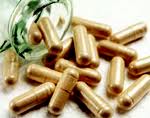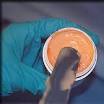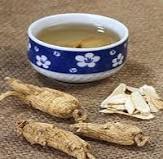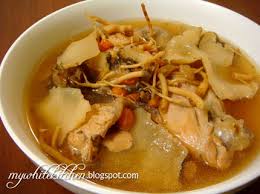Introduction/Name
The use of ginseng products are often featured in media advertisment, newspaper and health magazines. Ginseng is a popular herb in traditional Chinese medicine.
Ginseng is widely used in cooking. Many people boil ginseng root with chicken for health purposes.
The Chinese have been using ginseng as a medicinal ingredient since 5000 years ago. The name “ginseng” was coined following the pronunciation of the species name in Cantonese, jen shen and Mandarin, ren shen which means “human root”. This is because the branched form of the ginseng root resembles a human foot. The Latin or scientific name of this herb is Panax. Panax in Latin means perfect cure for all diseases. Ginseng is easily identified by its long branched and pale yellow roots.
Anatomy
The diagram below provides the anatomy of a ginseng plant
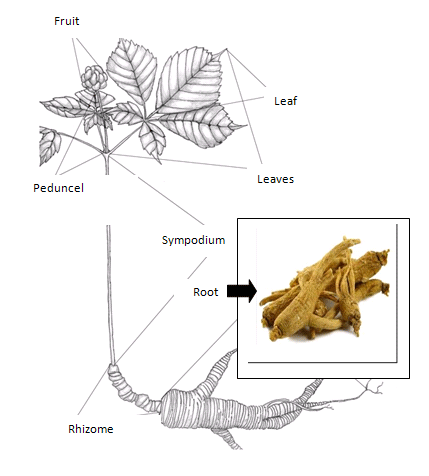
Ginseng Species That Have Reliable Health Benefits
Ginseng is a plant that can grow to about 60cm and is found in the cool mountains of East Asia. These days, ginseng is also widely planted in Korea, Siberia, Manchuria and United States of America. Ginseng is a slow-growing plant and its height may not reach more than 10-20cm after many years of growth. The part of ginseng recognized to provide health benefits is in its root. Due to its slow growth rate and limited availability, the price of the ginseng root is very expensive. The older the age of ginseng root, the more beneficial it is thought to be.
The three common types of ginseng used in order of popularity are
- Asian atau Panax ginseng (Panax ginseng)
- American ginseng (Panax quinquifolius)
- Siberian ginseng (Eleutherococcus senticosus)
Asian ginseng when processed is also known as Korean or Red ginseng. Hence, Korean ginseng is still derived from Panax ginseng.
Asian ginseng is traditionally used to treat cold symptoms such as weak pulse, shortness of breath, fatigue and cold limbs. Whereas American ginseng is used to relieve symptoms of heatiness.
American ginseng is suitable to be taken by consumers who are under stress, feeling hot and thirsty, as well as for athletes.
Siberian ginseng (Eleutherococcus senticosus) is also a type of ginseng but does not belong to the Panax genus. The differences between the Siberian ginseng and Panax ginseng are in terms of its active constituents and texture. The active constituent in Panax ginseng is called ginsenosides while for Siberian ginseng it is eleutherosides. The Panax ginseng root is also fleshy while the Siberian ginseng root is woody.
Diagrams of the different types of ginseng species
- Asian atau Panax Ginseng
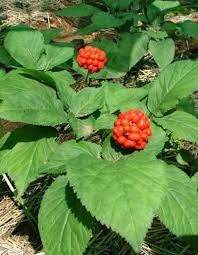
- American ginseng
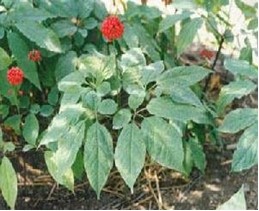
- Siberian ginseng

Dose Instruction
Dosage as recommended by the practitioner or as printed on the registered product label
Indications/Usage
In general, the root of this plant is believed to improve blood flow and by increasing the production of red blood cells helps in the recovery from illness.
In addition to this, ginseng is also believed to have the following effects
- Ginseng contains adaptogens. Adaptogen is a substance that increases the body resistant towards mental and physical stress.
- Reduces blood sugar level
- Reduces cholesterol level
- Increases stamina
However, clinical studies are needed to support the above claimed indications.
Indication Of Registered Ginseng Product
Ginseng products in pharmaceutical dosage forms and with traditional health claims are required to be registered with the Drug Control Authority (DCA) prior to sale in Malaysia. The registration number for a ginseng product usually ends with the letter “T” which means it is a Traditional product. (example: MALxxxxxxxxT). Traditional used indications allowed for registered ginseng products are:-
- to strengthen the body
- to increase energy
- to reduce fatigue during physical exertion
- for general health
Registered ginseng products are available in various dosage forms i.e. concentrated liquids, capsules, tablets and powder.
Cosmetic products containing ginseng too require to be notified with National Pharmaceutical Control Bureau (NPCB) prior to sale.
Side Effects
Common side effects are as follows:-
- Headache
- Vomiting
- Diarrhoea
- Insomnia (difficulty in sleeping)
- Allergic reaction
Please consult your pharmacist / doctor before taking this product.
Precaution / Warning Statement
- Safe use in lactating women and children has not been established
- Contraindicated in pregnant women
- Do not exceed the stated dose
- Safety on long term use has not been established
Types Of Dosage Forms Available In The Market
|
Tablet
|
Capsule
|
Cream(Cosmetic)
|
| Powder
|
Drink
|
Food
|
| Last Reviewed: | : | 06 June 2014 |
| Writer | : | Karen Wong Yoke Sim |
| Accreditor | : | Datin Shantini Thevanderan |



